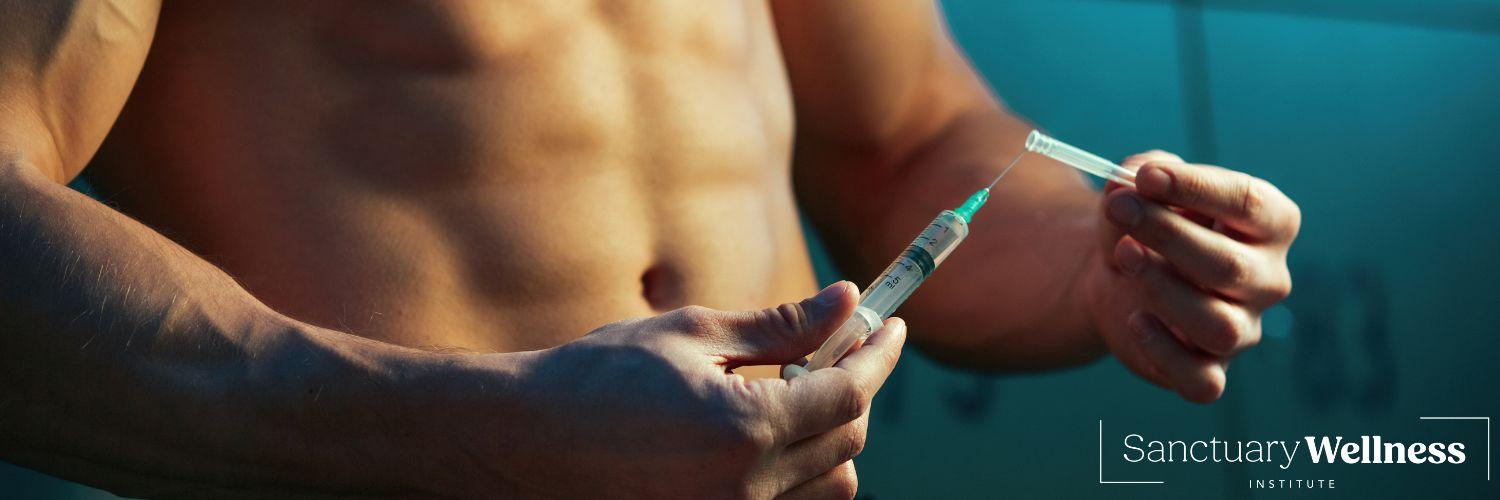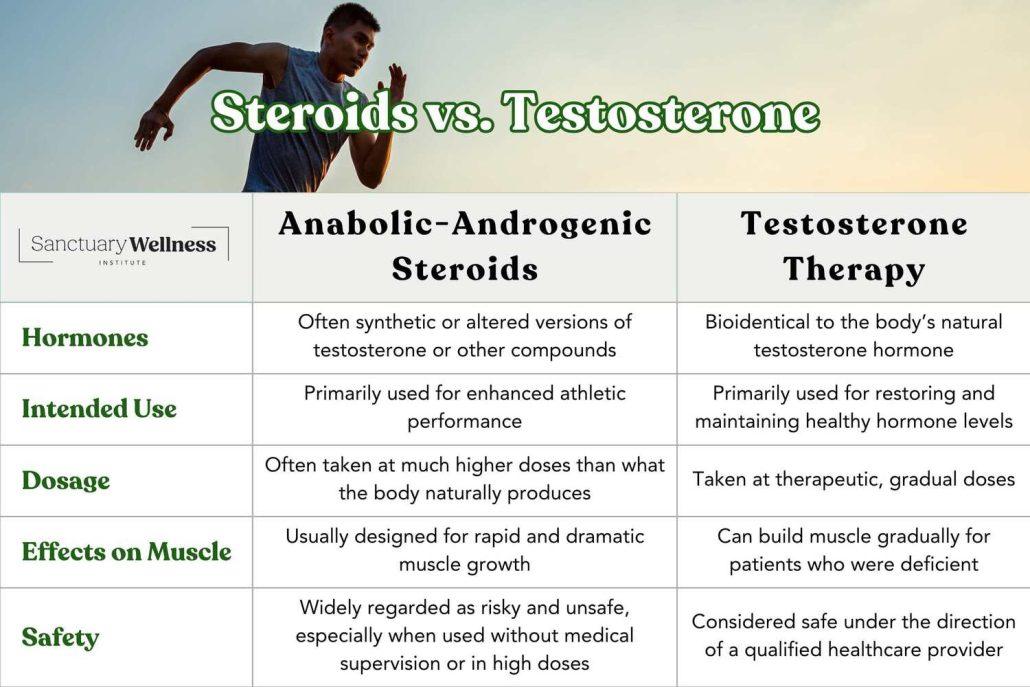- John DiBella
- Published: May 19, 2025
- Fact-checked by Dr. Desiree Granados

You might have heard the terms “testosterone” and “steroids” used interchangeably in the sports and fitness world, but they’re not exactly the same thing. Testosterone is a type of steroid, but receiving testosterone therapy does not refer to the same treatment as performance-enhancing steroids.
So is testosterone replacement therapy (TRT) the same as steroids? The short answer is “no.” In this article, we’ll explain the difference between medical hormone therapy and performance-enhancing drugs like anabolic-androgenic steroids (AAS).
Testosterone & TRT: Defined
Testosterone is a naturally occurring hormone that plays a crucial role in male development and health. It influences muscle mass, fat distribution, bone density, red blood cell production, mood, and sex drive. While women also produce testosterone, men generate it in significantly higher amounts, primarily in the testes.
Testosterone Replacement Therapy (TRT) may be prescribed to individuals who need help getting their hormone levels within a healthy range. As men age or face certain medical conditions, their testosterone levels may decline. This can lead to symptoms like fatigue, reduced libido, hair loss, depression, and loss of muscle mass. In such cases, TRT can be a great benefit to them.
Anabolic-Androgenic Steroids: Defined
Anabolic-androgenic steroids (AAS) are synthetic derivatives of testosterone designed to promote muscle growth and enhance physical performance. While they do have medical uses, such as treating delayed puberty or diseases that cause muscle loss, they are most commonly associated with bodybuilding and athletic performance enhancement.
Many anabolic steroids are taken in doses far exceeding what the body naturally produces. This can lead to rapid muscle gains, increased strength, and improved recovery, but also increases the risk of serious side effects, especially when used without medical supervision.

What Is the Difference Between Testosterone and Steroids?
The main difference between anabolic steroids and testosterone therapy lies in usage, dosage, and structure. Testosterone used in TRT is bioidentical to the hormone naturally produced by the body and is administered in therapeutic doses to treat medical deficiencies. Anabolic steroids, on the other hand, are often altered versions of testosterone or other compounds that mimic its effects, taken in much higher doses for performance enhancement.
Can you build muscle with TRT like you can with steroids? Yes, but within limits. TRT can help increase muscle mass if you were previously deficient, but it won’t give you the dramatic, rapid muscle growth seen with anabolic steroid abuse. Steroids are specifically engineered to maximize anabolic (muscle-building) effects, often at the cost of your health.
Another testosterone-based treatment that differs from AAS is “testosterone boosters,” which are over-the-counter supplements made from natural ingredients like herbs, vitamins, and minerals. Their goal is to encourage your body to produce more testosterone naturally. Unlike anabolic steroids, these testosterone boosters don’t contain synthetic hormones and generally have milder effects. They also have far less impact on muscle growth or hormone levels.
Side Effects of Testosterone vs. Steroids
Testosterone (TRT) Side Effects
When monitored and dosed correctly under medical supervision, TRT is generally safe. However, potential side effects include:
- Mild fluid retention
- Acne and oily skin
- Increased red blood cell count
- Mood shifts as body adjusts
- More rarely, sleep apnea
Anabolic Steroid Side Effects
Because anabolic steroids are often taken in much higher doses and without medical oversight, they pose more significant risks:
- Liver damage
- High blood pressure
- Increased risk of heart disease and stroke
- Mood swings and aggression (“roid rage”)
- Gynecomastia (male breast enlargement)
- Infertility and testicular atrophy
The risk level increases with prolonged use and stacking (using multiple types of steroids simultaneously).
Which Is the Right Choice for Me?
If you’re experiencing symptoms of low testosterone, a medically-supervised TRT program could help you restore balance and feel better physically and mentally. It’s not a shortcut to a muscular physique, but it can support a healthy lifestyle, especially when paired with regular exercise and a good diet.
On the other hand, anabolic steroids are often used for aesthetic or competitive reasons. Their use carries significant legal, ethical, and health risks, particularly when obtained illegally or used without medical guidance.
Ultimately, the right choice depends on your goals. If you’re seeking better health and quality of life, TRT may be appropriate. If you’re aiming purely for extreme muscle gain, understand that steroids come with serious consequences.
Conclusion
So, is TRT the same as steroids? Not at all. While both involve testosterone or related compounds, TRT is a medical treatment aimed at restoring normal hormone levels, whereas anabolic steroids are typically used for performance enhancement at potentially dangerous dosages.
Understanding the distinction is essential for making informed decisions about your health and fitness journey. Always consult a qualified medical professional before beginning any hormone therapy or considering performance-enhancing substances. A men’s health doctor from The Sanctuary Wellness Institute can help you understand whether testosterone replacement therapy is right for you and your health goals.
How we reviewed this article:
- Haoyang Cheng, et al. (2024). Age-related testosterone decline: mechanisms and intervention strategies
https://pmc.ncbi.nlm.nih.gov/articles/PMC11562514/ - Katherine Krive, DO. (Dec 2023). GoodRX.
https://www.goodrx.com/classes/anabolic-steroids/roid-rage - Stephen W. Leslie, Sajedur Rahman, Kavitha Ganesan (2025). Anabolic Steroids
https://www.ncbi.nlm.nih.gov/books/NBK482418/ - E Charles Osterberg, Aaron M Bernie, Ranjith Ramasamy (2014). Risks of testosterone replacement therapy in men
https://pmc.ncbi.nlm.nih.gov/articles/PMC3897047/ - NHS (2022). Anabolic steroid misuse
https://www.nhs.uk/conditions/anabolic-steroid-misuse/
Current Version
May 19, 2025
Written By
John DiBella
Fact-checked By
Dr. Desiree Granados
Editorial Process
Our Editorial Process

John DiBella is the co-founder and CEO at The Sanctuary Wellness Institute. His goal is to foster healthier lifestyles to improve individuals’ quality of life and health span through online medical and non-medical services. When he’s not writing health & wellness articles for The Sanctuary, he enjoys hiking, camping, surfing and sailing.







